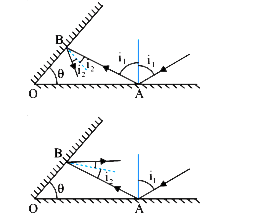Two plane mirrors are inclined at angle θ=60∘ with each-other. A ray of light strikes one of them. Find its deviation after it has been reflected twice-one from each mirror.
Case I:
δ1=clockwise deviation atA=180∘−2i1
δ2anticlockwise deviation at B=180∘−2i2
Now, from Δ OAB, we have
angle O + angle A + angle B = 180∘
⇒i1−i2=θ
As i1>i2,δ1<δ2
Hence, the net angle clockwise deviation=δ2- δ1
=(180∘−2i2)−(180∘−2i1)
=2(i1−i2)=2θ=120∘
Case II:
δ1=clockwise deviation atA=180∘−2i1
δ2anticlockwise deviation at B=180∘−2i2
Now, from Δ OAB, we have
angle O + angle A + angle B = 180∘
or, θ+(90∘−i1)+(90∘−i2)=180∘⇒i1+i2=θ
Hence, the net angle clockwise deviation=δ2+δ1
=(180∘−2i2)+(180∘−2i1)=360∘−2(i1+i2)=360∘−2θ
⇒Net anti-clockwise deviation =360∘−(360∘−2θ)=2θ=120∘

Similar Questions
Two plane mirrors are inclined at an angle θ with each-other. A ray of light strikes one of them. Find its deviation after it has been reflected twice-one from each mirror.
View SolutionTwo plane mirror are inclined to each other at 90∘. A ray of light is incident on one mirror. The ray will undergo a total deviation of
View Solution
Knowledge Check
Two plane mirrors are inclined to each other such that a ray of light incident on the first mirror and parallel to the second is reflected from the second mirror parallel to the first mirror. Determine the angle between the two mirrors:
Aa 0∘B( b) 45∘Cc 60∘Dd 90∘Two plane mirrors are inclined at an angle θ to one another A ray of light incident on the first mirror and parallel ot the second mirror is reflected from the second mirror parallel to the first mirror ,
What is the value of θA0∘B45∘C60∘D90∘Two plane mirror are inclined to each other at 90∘. A ray of light is incident on one mirror. The ray will undergo a total deviation of
A180∘B90∘C45∘Ddata insufficient
Two vertical plane mirrors are inclined at an angle of 60∘ with each other. A ray of light travelling horizontally is reflected first from one mirror and then from the other. The resultant deviation is
View SolutionTwo plane mirrors are inclined at an angle of 60∘ with each other. An incident ray hits one of the mirror at an angle of 80∘ with the normal. Its angle of deviation after two reflections is
View SolutionTwo vertical plane mirrors are inclined at an angle of 60∘ with each other. A ray of light travelling horizontally is reflected first from one mirror and then from the other. The resultant deviation is
View SolutionIf two plane mirrors are inclined at angle 0 to each other as shown, than angle of deviation of incident ray is

View SolutionTwo plane mirrors are inclined at an angle 1θ . If is found that a ray incident on one mirror at any angle is rendered parallel to itself after reflection from both the mirrors. The value of 1θ is
View Solution
